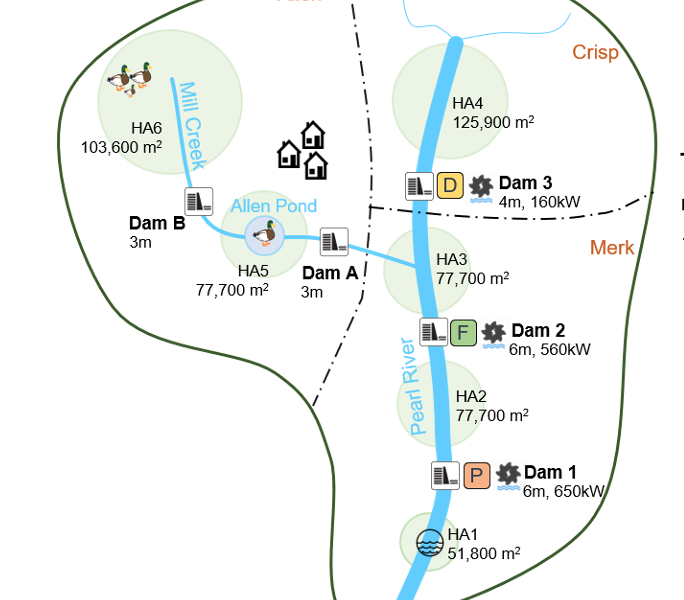Pearl River is a seven party, facilitated, multi-issue negotiation over the management of dams in a coastal basin.
Pearl River is a facilitated, multi-issue negotiation simulation for eight or nine participants about the management of five dams in the hypothetical Pearl River basin. This science-based negotiation simulation provides an opportunity for learning about and discussing larger-scale management of ecosystems, use of scientific data and modeling in environmental decision-making under uncertainty, and consensus-based negotiations over water resources. This simulation includes the Pearl River system dynamics model application, which simulates environmental and economic outcomes under different dam management alternatives.
The Pearl River basin is a coastal basin that includes the Pearl River and its tributary, the Mill Creek. Multiple stakeholders with diverse interests and concerns are interested in the dam-related issues in the basin. There are three hydropower dams on the Pearl River and two non-hydropower dams on Mill Creek. All dams have varying levels of fish passage, ranging from no passage to adequate passage. Dam A on Mill Creek is owned by the Town of Allen and has recently received a Notice of Public Safety from the State Water Resources Division (State WRD). The town must decide how to address the Notice and whether it makes sense to consider the future of other dams in the Pearl River basin as it makes its decision.
State WRD invited representatives from six other stakeholder groups to participate in a Working Group (for a total of seven stakeholder groups): the Federal Agency of Natural Resources (Federal ANR), the Historic Preservation Agency of the State (State Historic), Rivers-R-Us (an environmental nongovernmental, non-profit organization), the Allen Pond Homeowners Association (representing property owners along Allen Pond, the impoundment created by Dam A), HydroEnergy, LLC. (the hydropower developer which owns the three hydropower dams on the Pearl River), and the Town of Allen (which owns two non-hydropower dams on Mill Creek). The Working Group also includes one or two facilitators who will help manage the meeting. The main goal of the meeting is to develop a “Work Plan” for the future of Dam A and possibly for the other dams in the Pearl River basin. To support the Group’s efforts, a local university developed and shared a novel system dynamics model, which simulates the impacts of different decisions on fish populations, hydropower generation, and project cost. Negotiators can access the model during the negotiation via a web-user interface. The Working Group looks forward to using the model to find agreement on the following three decisions:
- Which dams should be included in the Work Plan and what dam management alternatives should be considered?
- Who is responsible for implementing the Work Plan?
- Who pays to implement the Work Plan?
The municipal, state, and federal officials have indicated they aim to act on the Work Plan if at least six out of the seven stakeholders support the agreement. If fewer than six stakeholders support the recommendations, the Town of Allen will decide on its own about next steps to respond to Dam A’s notice of deficiency.
Key lessons of this simulation include:
- Sustainable solutions to conflicts over dams meet multiple stakeholders’ interests and receive broad political, community, and financial support for implementation.
- Dam decisions are multi-issue negotiations that involve linked social and ecological systems, feedbacks over spatial and temporal scales, many stakeholders, overlapping legal and procedural frameworks, and scientific uncertainty.
- The most successful dam decisions pay careful attention to preparation, including ensuring the right parties participate, are prepared, and interact throughout to bring both expert and local/experiential knowledge to bear on the decision.
- A negotiation agenda should include opportunities for stakeholders to share information about quantifiable interests and non-quantifiable interests, time to brainstorm multiple alternatives and develop new alternatives, and time to agree on performance criteria for deciding between alternatives.
- Linking decisions across multiple dams within a river system can expand the range of alternatives available to meet multiple interests and optimize across social, economic, and environmental tradeoffs, as compared to making decisions about a single dam at a time.
- Dam decisions should be informed by credible scientific data about the likely impacts of decisions. A system dynamics model can provide information about the likely impacts of choices, such as how the decision to focus on one dam or a series of dams will affect outcomes for fish, cost, and hydropower generation.
- A neutral party can provide critical process management services before, during, and after decisions.
Download a free preview copy of the Pearl River Teacher’s Package to learn more about this simulation.
______________________
Take your training to the next level with the TNRC
The Teaching Negotiation Resource Center offers a wide range of effective teaching materials, including
- Over 250 negotiation exercises and role-play simulations
- Critical case studies
- Enlightening periodicals
- More than 30 videos
- 100-plus books
TNRC negotiation exercises and teaching materials are designed for educational purposes. They are used in college classroom settings or corporate training settings; used by mediators and facilitators seeking to introduce their clients to a process or issue; and used by individuals who want to enhance their negotiation skills and knowledge.
Negotiation exercises and role-play simulations introduce participants to new negotiation and dispute resolution tools, techniques and strategies. Our videos, books, case studies, and periodicals are also a helpful way of introducing students to key concepts while addressing the theory and practice of negotiation.
